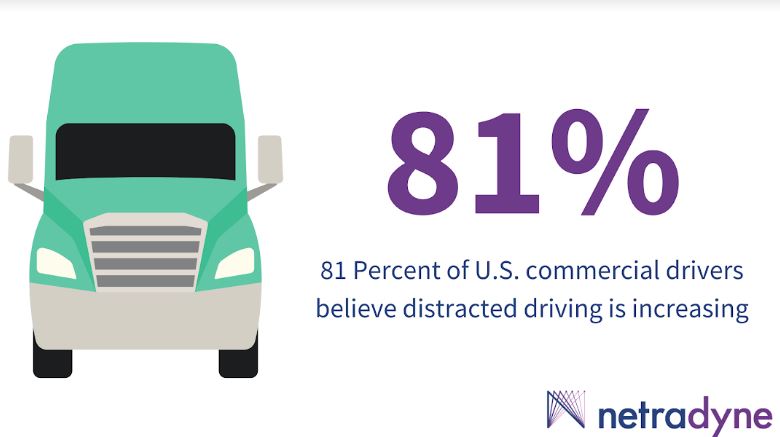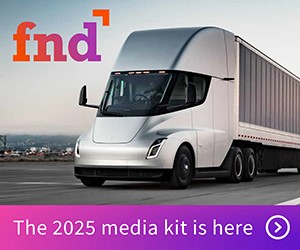Netradyne Survey Finds 81 Percent of U.S. Commercial Drivers Believe Distracted Driving is Increasing

Research reveals 9 in 10 commercial drivers feel safe driving, while 61 percent say they could be safer drivers; 20 percent worry about drivers becoming too reliant on “smart driving” technologies
Netradyne, a leader in artificial intelligence (AI) technology focusing on driver and commercial fleet safety, today announced new findings from a recent online survey of commercial drivers. Conducted by Harris Interactive and commissioned by Netradyne, the report indicates that while commercial drivers feel safe, they acknowledge they could be safer, and that AI-powered driving technology can be both beneficial and concerning. Combined with a companion survey of non-commercial drivers, both sets of drivers agree that distractions are on the rise, though there seems to be little self-awareness of who and what is to blame.
According to the National Safety Council, on a typical day, more than 700 people are injured in distracted driving crashes. Results of the survey indicate that when it comes to awareness of distractions, nearly 70 percent of commercial drivers and 73 percent of standard drivers want better blindspot detection. But when it comes to saying which drivers are the problem, the results suggest “not me” is the most likely answer. Commercial drivers are most likely to agree that their peers who transport commercial goods (72 percent) and passengers (69 percent) are safe drivers. Commercial drivers consider drivers of sports cars (38 percent) and convertibles (26 percent) to be the least safe.
This lack of self-awareness is part of what Netradyne’s Driveri system for fleets helps to address. Using cameras and AI powered edge computing, Driveri helps professional fleet drivers become aware of ways they can improve through behavioral motivation produced by Driver Star reports. The frequency of the reports is up to the respective fleets deploying Driveri, as are the perks for improving their good driving scores, but the results are encouraging for everyone who wants safer roads.
Netradyne found that on average, commercial drivers drive 7.4 hours per day, and the most common types of goods transported are construction materials (33 percent), local goods (30 percent), and foods or plants (20 percent). Not surprisingly, there are many hazards with longer hours, indicating a need for additional help to make the commercial driving experience, as well as the roads, safer.
“Because of the distractions on the road, the long hours, I believe that every vehicle, particularly those in commercial fleets, should have a camera,” said Adam Kahn, President, Fleet Business and Certified Transportation Professional (CTP®), Netradyne. “Technology is proven to have a huge impact on not only making the roads safer for everyone and reducing distracted driving with in-the-moment feedback, but fleets can save money by avoiding the incidents that the human brain can’t always anticipate.”
Key findings around distracted driving:
Driving distractions are on the rise
● Overall, the vast majority of commercial drivers feel safe while driving (86 percent) and there is a growing perception that driving is becoming safer over time (54 percent). Nevertheless, 81 percent are concerned that distractions are on the rise.
● Top five distractions for commercial drivers are drinking liquids, events outside the vehicle, looking at a GPS device, adjusting the in-vehicle audio and fiddling with vehicle controls.
● Social media and surfing the net is the most severe distraction experienced by commercial drivers. 71 percent of commercial drivers who’ve accessed social media and the net while driving found it distracting.
● Video and facetime chatting while driving is considered the second most severe distraction. 68 percent of commercial drivers who’ve taken part in those chats while driving found it distracting.
● 22 percent of commercial drivers have been injured in a distracted driving incident.
Negating distracted driving
● While a large majority of commercial drivers do things to prepare for their drive and reduce distractions, 68 percent regularly allow extra time for their journey to help negate distracted driving.
● 59 percent of commercial drivers regularly set their GPS before they start the engine and 55 percent regularly prepare all of their music for the entire trip.
A key component of on-the-road safety has been identified as artificial intelligence (AI) technology, which can both help and hinder drivers who don’t necessarily understand the technology at this point. For commercial drivers, AI can help with route recommendations, data collection and even driver coaching. Powered by AI, Netradyne’s Driveri captures every minute of every driving day of thousands of fleet drivers across the country, analyzing road conditions, driving events and violations. Netradyne is using technology to help make the roads safer.
Key findings from the survey reveal commercial driver attitudes toward AI:
Mixed feelings about AI technology indicate it’s misunderstood
● AI, which can provide ongoing, constructive feedback (such as Netradyne’s GreenZone) appeals to 72 percent of commercial drivers who say they are open to feedback at least once a week.
● However, 20 percent of drivers feel that other drivers may rely on technology more than their own judgement.
● Still, top commercial drivers use of technology includes hands-free phones (43 percent), a camera to view the outside of the vehicle (36 percent), a GPS device (29 percent), and other assistance that includes lane departure warnings, voice recognition, and automatic braking.
AI beginning to be recognized as making the roads safer
● Over 50 percent of commercial drivers feel that smart tech has had a positive impact on driver safety. This is driven by a belief that smart technologies help them to stay focused when driving (23 percent) while 21 percent believe that it gives them the ability to make more accurate decisions.
● In terms of priority, 69 percent of commercial drivers are particularly interested in AI technology that will help them monitor blind spots and 68 percent are interested in information on vehicle maintenance issues while 63 percent are looking for technology to feed them information about the road.
● 73 percent of commercial drivers are interested in receiving feedback once a week or more. They are more interested to hear what they do well than what they need to improve (40 percent).
● Regarding feedback on their driving, 44 percent of commercial drivers prefer a mix of numbers-based feedback and verbal/written coaching, as opposed to simply a numbers-based feedback report (19 percent).
“Netradyne has proven successful in making our roads safer for all drivers by equipping professional drivers with AI technology,” said Avneesh Agrawal, chief executive officer of Netradyne. “With greater understanding of the challenges we face on the road, all drivers will benefit by alerts for behavior adjustment, fewer distractions, fewer accidents and injuries, and even lower insurance premiums.”
Methodology:
This Netradyne survey was conducted online within the United States by Harris Interactive from February 25 to March 16, 2020 among 350 commercial drivers. Participants were aged 18+ and held a commercial driving license and drove a commercial vehicle once per week. Results were weighted for age, gender, region, urbanicity, race/ethnicity, education, marital status, household income, and/or socio-economic status to be nationally representative, with a margin of error of two percent at a 95 percent confidence level.
Category: Accessories, Connected Fleet News, Driver Stuff, Featured, General Update, News, Safety, Tech Talk










